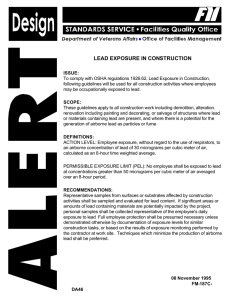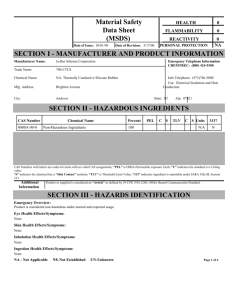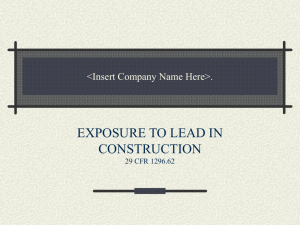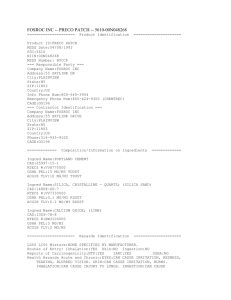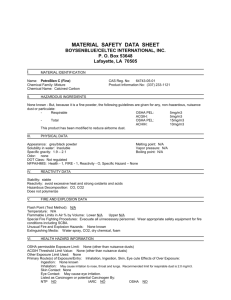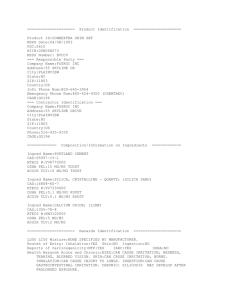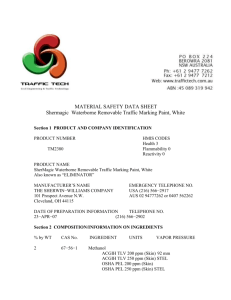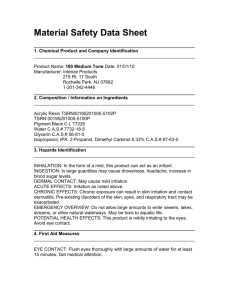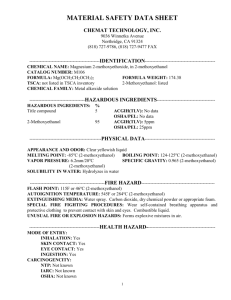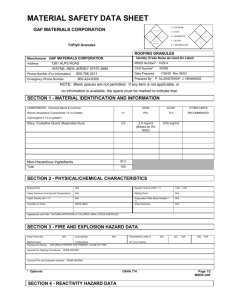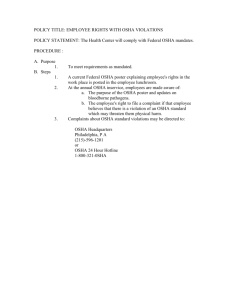osha's lead standards employee training
advertisement
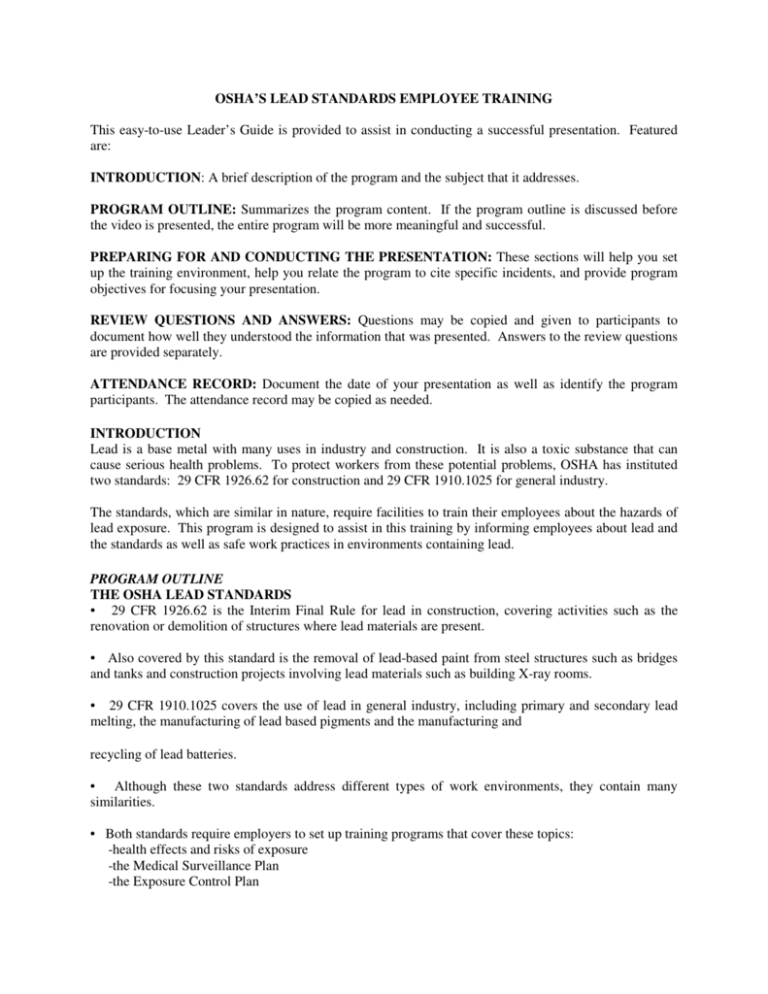
OSHA’S LEAD STANDARDS EMPLOYEE TRAINING This easy-to-use Leader’s Guide is provided to assist in conducting a successful presentation. Featured are: INTRODUCTION: A brief description of the program and the subject that it addresses. PROGRAM OUTLINE: Summarizes the program content. If the program outline is discussed before the video is presented, the entire program will be more meaningful and successful. PREPARING FOR AND CONDUCTING THE PRESENTATION: These sections will help you set up the training environment, help you relate the program to cite specific incidents, and provide program objectives for focusing your presentation. REVIEW QUESTIONS AND ANSWERS: Questions may be copied and given to participants to document how well they understood the information that was presented. Answers to the review questions are provided separately. ATTENDANCE RECORD: Document the date of your presentation as well as identify the program participants. The attendance record may be copied as needed. INTRODUCTION Lead is a base metal with many uses in industry and construction. It is also a toxic substance that can cause serious health problems. To protect workers from these potential problems, OSHA has instituted two standards: 29 CFR 1926.62 for construction and 29 CFR 1910.1025 for general industry. The standards, which are similar in nature, require facilities to train their employees about the hazards of lead exposure. This program is designed to assist in this training by informing employees about lead and the standards as well as safe work practices in environments containing lead. PROGRAM OUTLINE THE OSHA LEAD STANDARDS • 29 CFR 1926.62 is the Interim Final Rule for lead in construction, covering activities such as the renovation or demolition of structures where lead materials are present. • Also covered by this standard is the removal of lead-based paint from steel structures such as bridges and tanks and construction projects involving lead materials such as building X-ray rooms. • 29 CFR 1910.1025 covers the use of lead in general industry, including primary and secondary lead melting, the manufacturing of lead based pigments and the manufacturing and recycling of lead batteries. • Although these two standards address different types of work environments, they contain many similarities. • Both standards require employers to set up training programs that cover these topics: -health effects and risks of exposure -the Medical Surveillance Plan -the Exposure Control Plan -air monitoring procedures -use and care of respirators -workplace and personal hygiene -work area housekeeping -the Medical Removal Protection Program • Training must take place before employees can begin work and refresher training is required annually. HEALTH EFFECTS OF LEAD EXPOSURE • Lead can enter the body through ingestion and inhalation; once in the stomach or lungs, lead can be absorbed into the bloodstream and circulated throughout the body. • Chronic overexposure happens when small amounts of lead accumulate in the body over a long period of time; acute overexposure occurs when a large amount of lead is absorbed in a short time. • Chronic overexposure, where symptoms may include headache, dizziness, nausea, etc., can damage the blood, urinary, reproductive and nervous systems. • Encephalopathy is a serious result of acute overexposure and can cause death within 48 hours. THE MEDICAL SURVEILLANCE PROGRAM • Required by OSHA, the Medical Surveillance Program provides for medical tests free of charge to the employee. • Blood samples are taken to establish a person' s existing lead levels; other tests are performed on the lungs to show their condition and capacity. • A person' s medical history is also detailed with these tests; the results determine the employee' s toleration for lead exposure and the ability to use PPE. THE EXPOSURE CONTROL PLAN • Your company' s Exposure Control plan re-quires action to be taken at lead' s "Action Level" and "Permissible Exposure Limit" (PEL). • The Action Level is the actual amount of lead in the air; at 30 micrograms per cubic meter of air per hour, your company must provide training, periodic air monitoring and medical surveillance. • Airborne lead concentrations are measured with personal air monitors. • The PEL, which is 50 micrograms per cubic meter of air per hour, is the highest level of lead in the air which OSHA allows a worker to be exposed to during an 8 hour shift. • Engineering controls, such as mechanical ventilation systems, can be used to keep lead levels below the PEL. • Job rotation and shorter work shifts are administrative controls that reduce exposure. • If controls don' t reduce the PEL, respirators must be used to limit exposure. • The Exposure Control Plan must also include a description of all job tasks involving potential lead exposure, recorded results of air monitoring and a schedule for inspections. EXPOSURE ASSESSMENT • The Exposure Assessment determines if lead levels exceed the Action Level and may be based on previous air monitoring results from the same or similar work situations. • If the assessment determines that the lead concentration is above the Action Level, then Air Monitoring is required. • Employees can wear air pumps to the waist or sampling cassettes taped to the shoulder for monitoring air samples over an 8 hour shift. • If lead levels are below the PEL, no action is required; if they are above, the company must implement the appropriate control methods. • Results of the monitoring must be given to employees in writing within 5 days. RESPIRATORS • The standards require specific types of respirators for escalating amounts of the PEL. • An overall Respiratory Protection Program is required for work sites where other controls do not reduce exposure to below the PEL. • OSHA requires employees to receive respirator training in use, fit-testing, maintenance and limitations. HYGIENE FACILITIES • The standards require employers to set up "Hygiene Facilities" with "clean" changing rooms and "dirty" areas for changing and discarding contaminated work clothing. • Eating areas must be kept free of lead contamination. • Shower facilities must be set up where feasible; employees must wash hands and face where there are no showers before leaving work. • HEPA vacuums can be used to remove dust from work clothes and job sites. MEDICAL REMOVAL • Medical Removal requires an employee to stop working temporarily in lead exposure areas. • This may occur when Blood Lead Levels are above 50 micrograms per deciliter or by doctor' s recommendations. • Earnings, benefits, job status and seniority must be continued for 18 months or until the work assignment is complete. • Medical Removal Benefits can be reduced in several ways: workers compensation benefits, unemployment benefits, income from other jobs and other sources of earnings. • The lead standards require employers to maintain a series of medical records that should be made available to the employee or employee’s representative. PREPARE FOR THE SAFETY MEETING OR TRAINING SESSION Review each section of this Leader' s Guide as well as the videotape. Here are a few suggestions for using the program: Make everyone aware of the importance the company places on health and safety and how each person must be an active member of the safety team. Introduce the videotape program. Play the videotape without interruption. Review the program content by presenting the information in the program outline. Copy the review questions included in this Leader' s Guide and ask each participant to complete them. Copy the attendance record as needed and have each participant sign the form. Maintain the attendance record and each participant' s test paper as written documentation of the training performed. Here are some suggestions for preparing your videotape equipment and the room or area you use: Check the room or area for quietness, adequate ventilation and temperature, lighting and unobstructed access. Check the seating arrangement and the audiovisual equipment to ensure that all participants will be able to see and hear the videotape program. Place or secure extension cords to prevent them from becoming a tripping hazard. CONDUCTING THE PRESENTATION Begin the meeting by welcoming the participants. Introduce yourself and give each person the opportunity to become acquainted if there are new people joining the training session. Explain that the primary purpose of the program is to help the viewer understand OSHA’s lead standards and exposure to lead in the work place. Introduce the videotape program. Play the videotape without interruption. Review the program content by presenting the information in the program outline. Lead discussions about facility operations, procedures and possible exposure to lead. Use the review questions to check how well the program participants understood the information. After watching the videotape program, the viewer will be able to identify the following: • The components of the lead standards and how they protect workers; • Symptoms of lead exposure and overexposure; • Proper PPE and safe work procedures for work-ing in lead-contaminated environments. OSHA’S LEAD STANDARDS EMPLOYEE TRAINING REVIEW QUIZ Name__________________________________Date_______________________________ The following questions are provided to check how well you understand the information presented during this program. 1. Name the two types of work covered in the lead standards. 2. What is the most common way that lead enters the body? 3. Long-term lead exposure can damage which two areas of the body? 4. At which level has OSHA set the limit for a person to be exposed at the Permissible Exposure Limit (PEL) during an eight-hour day? a. 25 micrograms per cubic meter per hour b. 50 micrograms per cubic meter per hour c. 50 micrograms per cubic meter per eight-hour day 5. a. b. c. OSHA has set the Action Level for lead exposure to be ______________ the PEL. higher than the same as lower than 6. Your employer must inform you in writing of your Blood Lead Level after receiving the results of any blood test you are given. a. true b. false 7. Earnings, benefits, job status and seniority must be continued for _______________ or until the work assignment is complete. a. b. c. d. one year eighteen months two years thirty-six months OSHA’S LEAD STANDARDS EMPLOYEE TRAINING ANSWERS TO THE REVIEW QUIZ 1. industrial and construction 2. inhalation: breathing airborne lead dust and/or fumes 3. blood, kidneys, nervous system, reproductive system 4. b 5. c 6. a 7. b
